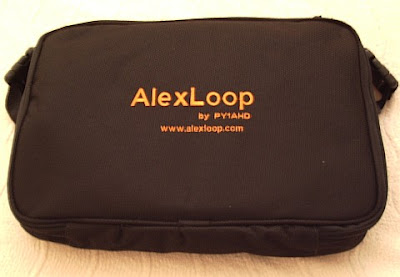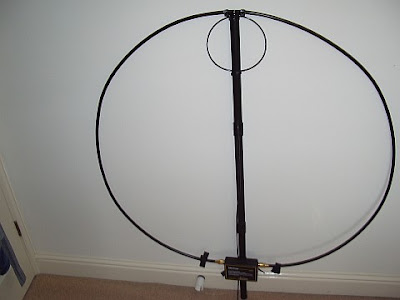Posts Tagged ‘AlexLoop’
 The Alexloop vs my attic dipole
The Alexloop vs my attic dipole
| The new Alexloop antenna |
| A quality case |
So lets get to the nuts and bolts.....how does it work....sure anyone can say anything about their antenna but the proof is in the radio waves!!
| Antenna location..cat standing guard |
I wanted to do a comparison between my attic dipole which is the Alpha Delta DX-EE up about 30 feet in the attic and the Alexloop set up in my XYL's office just opposite my radio room. Let me state that this is not a comparison to see which antenna preforms better as that is not a fair comparison....but I wanted to see how well the loop did compared to my attic dipole. The Alexloop was mounted on a tripod....well ty-wrapped to it as the the Alexloop would not fit over the tripod center pole section. This is something I will have to work out later. Each of these antennas have their disadvantages....the dipole is in the attic, this means a wooden roof above, rafters all over and insulation below. The Alexloop is in a second floor room, it's a small loop antenna and very close to the ceiling. So really both antenna are far from ideal when it comes to location.
| Temp tripod mount |
My overall impressions of the Alexloop are as follows:
1. Shipping was fantastic, this antenna got here from South America faster than products I have ordered from the U.S.
2. The support is great, I had a question about the loop when it arrived and it was answered within 30 minutes!!!!
3. This unit is quality quality quality from the carry case to antenna!!
4. The tuning was a cinch, turn for peak noise and then transmit and tune for lowest SWR....takes about 20 seconds!
| 14.060, 7.032 Alexloop |
6. Antenna foot print is very low profile and can be used vertical or horizontal.
7. The SWR on 20m and 40m (only bands used so far) was 1.4 at 14.060 and 1.7 at 7.032.
The bottom line is I am very very impressed with this antenna and I will be taking it to the field and updating the blog on how it does. Up to this point would I recommend this antenna.......dam right I would it's support is excellent, quality of the product is way above par and so far the results have been very impressive.
 AlexLoop gets an airing
AlexLoop gets an airing
Several of my readers have been patiently waiting to know how the AlexLoop and KX3 have been performing together. I am interested too, but I’m not yet well enough to attempt any outings with a rucksack full of radio gear. Today it was raining and I wouldn’t have wanted to go out anyway. So I decided to operate portable from inside the warm, dry shack instead.
The AlexLoop was assembled, mounted on its tripod and stood in a corner of the shack. The position is far from ideal: my shack is really small and the antenna was too close to the shelves containing books, magazines and equipment. I could only get an SWR of around 5 to 1 on the higher bands. I used the KX3’s built-in AMU to take care of it. That’s not how a magnetic loop is supposed to be used, but in this situation there’s no alternative.
The KX3 was run off the shack power supply so the power out was the full 10 watts. I hope to find a battery that will provide enough volts that I can run 10 watts in the field, but as I don’t yet have one this was a little bit of cheating!
The first band I tried was 12 metres. Here, Valery, ER3ZZ in Moldova came back to my first call and gave me a 5 and 5 report. Easy peasy.
Next stop was 10 metres, where Yakov RA9XAU quickly replied to my call. Another 5 and 5 was logged. Can, TA3GO was next in the log. This time a 5 and 9 was received.
One EA9 didn’t want to talk to me as I wasn’t DX. That would actually have been an all-time new country for me, as I think Ceuta-Melilla is a separate entity from Spain. Victor, RV3RM was working other G stations and gave me a 5 and 8 report.
After lunch I spent some time listening to, and attempting to call, Stateside stations. Some were very strong but I couldn’t be heard over the pile of stations calling them. That would have been quite a scoop – to cross the Atlantic with QRP and a portable antenna. I heard Yuri UT9MZ working Europe so I called him and 5 and 9 reports were exchanged.
I spent some time listening on other bands. Peter I5CTE was a massive signal – genuinely peaking more than S9+20dB on the KX3’s S meter. on 15m. Italy is a good direction for me, for some reason. We had a proper chat lasting several minutes and Peter told me that my QRP signal peaked over 5 and 9 at times.
My very subjective conclusion is that the AlexLoop feels no different in operation than my attic multiband dipole and MFJ magnetic loop. I didn’t even feel at a particular disadvantage from the low power, except perhaps when I was attempting to work USA stations. The AlexLoop is a very good antenna and together with the Elecraft KX3 make for a potent combination, especially if you can take advantage of the KX3’s full 10 watts output.
 AlexLoop teams up with KX3
AlexLoop teams up with KX3
Just a few days after I wrote that the AlexLoop WalkHam is a great companion for the Elecraft KX3 and here is a video by Steve WG0AT showing the combo in action.
5 and 9 using QRP SSB! I can’t wait until I’m fit enough to take the KX3 and loop to the outdoors myself.
 Looping the loop
Looping the loop
Whenever I have taken a rig to operate in the Great Outdoors using a wire antenna I have often been disappointed. This is probably due to my use of inadequate antennas – Miracle Whips and the like. When I have tried wire I usually fail to get it up high enough. Usually when hurling a rock attached to a string into the trees, the rock rebounds off a branch and narrowly avoids hitting me on the head. If I do manage to get it up high the rock irremovably entwines itself with a branch just out of reach. There has to be a better way!
 |
| AlexLoop WalkHam carrying case |
I have long been an enthusiast for magnetic loop antennas and have often wished I could use one as a portable antenna. My Wonder Loop was an attempt to make such an antenna, but it was less portable than transportable (by car) and has seen more use as a spare antenna from inside the shack.
I looked longingly at the WalkHam made by Alex PY1AHD and wished I could make a portable loop as neat and compact as that. If I had to make it myself it might never get done so I decided to bite the bullet and buy one of Alex’s ready-made loops.
There are two versions of the AlexLoop. One is a kit using copper tube for the radiating element and costs $199 US. The other version, called the WalkHam, uses stout coaxial cable for the main loop and comes ready built in its own custom made carrying case similar to a laptop case. The price of the AlexLoop WalkHam is $299 US. Shipping to the UK by express courier to the UK is a further $82 US. The total cost to me using PayPal was just over £250 at the present exchange rate.
 |
| AlexLoop WalkHam in its case |
The WalkHam is well made with gold plated connectors for the loop element. It is easy to assemble, though not so easy to pack away unless you have a photo to show how the parts go back! The mast is made of black plastic tubing and is in three push-together sections. Once assembled the antenna may be used whilst held aloft – hence the name. Most users will probably prefer some sort of mast.
 |
| The AlexLoop WalkHam ready for use. |
The loop is 1 metre in diameter and tuned using an air spaced variable capacitor with a 3:1 reduction drive giving a 4 : 1 tuning range: 10m – 40m. Most magnetic loops including home-made ones only manage a tuning range of 3:1: 10m – 30m or 15m – 40m. My MFJ magnetic loop is the 40m – 15m version as it was bought during the last solar minimum when 12m and 10m were not much use!
The coupling loop has a diameter of about 20cm. The maximum power handling is 20 watts PEP, 10 watts continuous wave, making the WalkHam perfect for use with QRP radios like the FT-817 or Elecraft’s new KX3!
Tuning as expected of a magnetic loop is extremely sharp but I noticed little or no hand-capacitance effect. With a little practice the loop can be tuned by peaking for maximum noise in the receiver. If the SWR isn’t low enough then the tuning may be touched up using transmit and the rig’s built-in SWR meter if it has one (both the FT-817 and KX3 do!) If not, a simple SWR indicator as I used in my Wonder Loop would be a big help.
Subjectively the AlexLoop seems to work as well as my MFJ magnetic loop in the attic, which itself is comparable to a full-size dipole. There are not many portable antennas that would beat the AlexLoop WalkHam for performance, unless you are able to erect a couple of 40-foot masts!
One thing that would improve the package would be a way of erecting the antenna so that it will stand on its own. I think my arm would soon get tired holding the WalkHam aloft! Possibly a short guyed mast made of sections of electrical conduit would do the job: magnetic loops don’t need to be far above ground in order to work. Some users are reportedly using photographic tripods so I’ll probably investigate that in due course.












